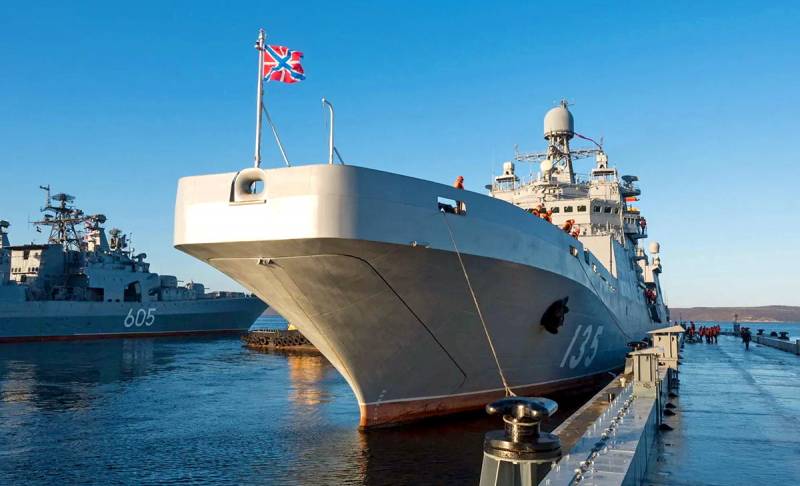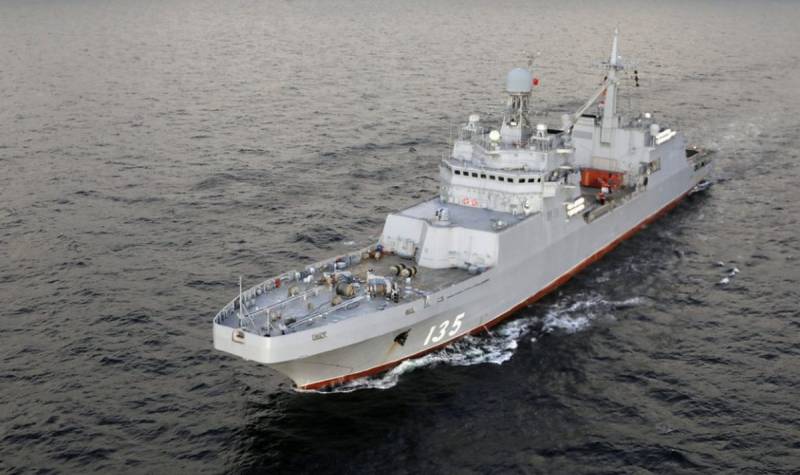Airborne fleet of Russia. Difficulties and problems
The final article in the series about large amphibious assault and universal amphibious ships, which have recently replenished and replenished the domestic Navy. V firstthe material was about the epic with the French "Mistrals", and told how the new project 23900 UDC of the "Ivan Rogov" type differs from them. In secondIn the text, I touched upon the combat use of this class of ships, and what additional options they can still carry. In the final text, we will talk about the difficulties and problems that lie in wait for us on the way to create a new class of ships.
It would seem that the ships are being built, they will be commissioned in 2028 and 2029, what problems could there be? However, this is where they begin. It must be understood that the UDC is only part of the system, for them BMPs, optimal in terms of tactical and technical characteristics, must be created, helicopters, boats specially built for use with such ships, and not just any, and even the staff organization of the Marine Corps and the design ships must match each other. It was then that the dog dug.
Let's start with the helicopters. Russia has the world's best naval attack helicopter, the Ka-52K. This is a good machine, it is mass-produced, and there is no need to fear which helicopters will perform strike missions. But there is a problem with transport helicopters. They simply do not exist. Today, Russia does not manufacture ship transport helicopters, nor does it manufacture multipurpose or special landing helicopters. All the Ka-29s that were planned to be used on the Mistrals, and then on the Ivan Gren large landing craft, are helicopters built during the Soviet era and restored after many years of storage. They simply will not be enough for these two projects and those ships of the Navy, which must also carry them. The Lamprey (a new generation naval helicopter), once promised to the fleet, has extremely vague prospects. And even if there are no special problems before this project, the first helicopters will begin to arrive in 15-20 years. Ships by that time will probably have already been built. What landing helicopters will fly from them? The question hangs in the air.
The last thing I fear is for the boats. This is the smallest problem - in ten years from the moment the UDC was laid, a boat can be designed and put into series. But we must not waste time, since coordinating different projects with each other is not our strong point, alas.
But there are a lot of problems with an infantry fighting vehicle. The requirements for it are increased - it must be capable of delivering troops by sea for 10-15 miles, moreover, in a high wave, and at the same time it must still have fuel for the next offensive by land. There is a very advanced and potentially very interesting Omsktransmash project. In this project, Omsk engineers provided for all the nuances of the combat use of such equipment, from seaworthiness to weapons, and the most suitable layout for such a machine. There are exactly two problems here - firstly, the project is expensive, and so that by the time the ships enter service, the new armored vehicles are already in the marines, it needs to be dramatically accelerated right now, sparing no funding. The second problem is its complexity. The coefficient of technical novelty of the vehicle is much higher than that of the Armata tank, and there are no guarantees that it will work out on the first try.
I hope that in the remaining time all these problems will be resolved and the new ship will not remain a "thing in itself", but will become part of the amphibious operations system, as is the case with the same Americans.
Large landing craft project 11711 of the "Ivan Gren" type
It remains to highlight the promised issue of support ships, which, according to the idea of the Russian Ministry of Defense, are intended to be the new Project 11711 large landing craft. This is a series of Russian large amphibious assault ships of the 1st rank of the near and far sea zone, designed for landing troops, transporting military equipment, cargo vehicles and equipment. The project was developed by the Nevsky Design Bureau as a further development of the Project 1171 Tapir large landing craft.
The lead ship of the Ivan Gren series entered service in June 2018. In the same year, in May, the second large landing craft of the basic design "Pyotr Morgunov" was launched, in December last year it was already handed over to the Customer and became part of the Northern Fleet (like the lead ship of this series). On April 23, 2019, at the Yantar shipyard in Kaliningrad, the laying of the 3rd and 4th large landing ships of the modified project 11711 of the Vladimir Andreev type with an increased gross displacement of up to 8000 tons - Vladimir Andreev and Vasily Trushin took place. Their transfer to the Customer is scheduled for December 2023 and 2024, respectively. Both will be part of the Pacific Fleet. As you can see, by the time the two newest Project 23900 helicopter carriers appear, we will have four 1st rank BDKs in service. We haven’t laid such ships for a long time.
I must say that the previous project 1171 "Tapir" was very successful. Over the decades of service in the USSR Navy and the Russian Navy, these ships have proven themselves very well. The developers took all the best from them, significantly enlarging the ship ("Tapir" belonged to the ships of the 2nd rank), and, in accordance with the requirements of the time, major changes in the design of the superstructure and internal premises. First of all, the efforts of the designers were aimed at reducing the ship's visibility through the use of modern materials and technical solutions, and attention was also paid to improving the living conditions for the crew and the landing force. There are two types of equipment loading onto the ship - either independently by ramps, or by cranes. In the troop compartment, it is carried out through a four-wing cargo hatch in the upper deck using a crane with a lifting capacity of 16 tons. For loading boats, motor boats and equipment on board, there are also two boat cranes. Also, the cargo hatch is used to ventilate the exhaust gases of equipment from the under-deck space (troop compartment). Combat equipment is located on the tank deck. These can be both main battle tanks weighing up to 60 tons (up to 13 units), and armored personnel carriers or infantry fighting vehicles (up to 36 vehicles), trucks (up to 30 vehicles), or up to 300 paratroopers. In addition, the ship has a deck hangar for ship-based helicopters: two transport-combat type Ka-29, or one reconnaissance-strike type Ka-52K. There are three motor boats on board.
The main power plant of the BDK consists of two two-shaft diesel-reverse-gear units DRRA-6000 based on two diesel engines 10D49 produced by JSC "Kolomensky Zavod" with a capacity of 5 hp. each, two gearboxes of PJSC "Zvezda" and a local control system of NPO "Aurora". As weapons, in order to save money and in connection with the changed concept of using these ships, it was decided to abandon the planned one 200-mm artillery mount A-100, two anti-aircraft artillery complexes "Broadsword" and two launchers of the multiple launch rocket system A-190 "Grad-M" in favor of the 215P-5-10 radar fire control system, which provides simultaneous control of artillery installations: 03 × 1 mm AK-30M-630 Duet, 2 × 2 mm AK-30M and two machine guns 630 × 2, 14,5 mm MTPU "Sting". Also on the BDK there is a complex of fired passive jamming KT-308-04 "Prosvet-M".
Below I will give the performance characteristics of the BDK project 11711:
Displacement, tons: 5 (standard), 000 (full)
Length, m: 135,0 (maximum)
Width, m: 16,5 (at design waterline)
Height, m: 11,0 (side)
Draft, m: 3,8 (maximum)
Propeller: 2 shafts, 2 propellers, bow thruster PU100FM
Travel speed, knots: 16 (economical), 18 (full)
Cruising range, nautical miles: 3500 (at 16 knots), 4000 (at 14 knots)
Autonomy, days: 30
Crew, people: 100.
According to the modified design, the new large landing craft "Vladimir Andreev" and "Vasily Trushin" will undergo the following changes:
The total displacement will be increased to 8000 (7000 standard) tons, the length is up to 150 m, the width is up to 19,5 m (at design waterline), the side height is up to 11,8 m, the draft will be 4,5 m, and the crew will increase to 120 human. Full speed will remain the same at 18 knots, but the cruising range will be increased to 5000 miles. The landing capacity will also be increased to 40 armored vehicles, to 400 paratroopers, to 5 Ka-27, Ka-29 or 4 Ka-52K helicopters, to 6 Serna landing boats. The armament will be further reduced to 76,2 mm art. installation AU AK-176MA. The power plant will be strengthened, it will consist of two two-shaft diesel-diesel units DDA-12 (000 diesel engines 4D10) of Kolomna Plant JSC, two gearboxes of PJSC Zvezda and a local control system of NPO Aurora. Also, they will differ from the base project in the add-on and some other changes, while the cipher of this project will not be adjusted.
As you can see, the design, power plant, armament and landing capacity were changed in accordance with the new requirements facing the ships of this class (when the lead ship of this series "Ivan Gren" was laid in 2004, we did not even think about any UDC).
This concludes the review of the state of affairs in our amphibious fleet. The Russian Federation again claims the status of a maritime power, whose interests extend far beyond its land borders, which it lost along with the power of the USSR Navy. With the appearance in the state of the Russian fleet of two helicopter carriers, which can be used as floating command headquarters, the Russian Federation can move from passive defense to active attack. But so far this is not included in our plans and has not been reflected in our military doctrine. But the bird, as they say, pecks by the grain.
- Vladimir Volkonsky
- Ministry of Defense of the Russian Federation


Information